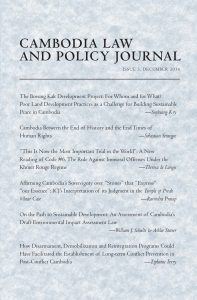BY NHEAN SOCHEAT
In recent news reports, we have seen some Cambodians applauding the repatriation of priceless, long-lost antiquities that were looted during the country’s violent 1970s. Last year, two pandava brothers (kneeling attendants from the Hindu epic Mahabharata) were shipped from the United States back home to Cambodia after being absent for more than four decades. This week, another statue — Duryodhana, also from the Mahabharata — is scheduled to arrive home. The return of these three statues serves as a reminder that Cambodian antiquities that remain abroad must be brought home.
Cambodia experienced massive looting of cultural property during the 20th century. Thieves and looters often took advantage of the conflict and poverty ravaging the Kingdom to smuggle cultural property out of the country, many times without opposition. In the early 1970s, Cambodia was plunged into war and later mass killing. The countryside was in a chaotic state, allowing smugglers to violently remove centuries-old statues and spirit them overseas.
Great numbers of Cambodian statues remain on display at museums in France — perhaps even more than you can see at the National Museum in Phnom Penh. Many of these were taken out of Cambodia throughout the almost century-long French colonial period — one of the Kingdom’s darkest times. Whether the artifacts were looted by the French for profit or because Cambodia did not have enough experts and technicians to preserve them or to promote Khmer culture abroad is not at issue. Regardless of the reason they were taken, all must be returned to their original sites. If these objects were looted for profit, they need to be reclaimed and returned home. If they were transported to France to be preserved, they still need to be returned, especially as Cambodia is now in a far better position to restore, preserve and properly display them.
While we may put the blame on the Khmer Rouge or others for bringing the country to chaos and thus enabling looting, we should not forget that an even greater number of cultural objects were moved out of the Kingdom during the French protectorate period. During that time, Cambodians who were witness to antiquities being taken away dared not protest or try to prevent it. The French had absolute power to do whatever they chose.
Bringing statues back home means a lot to Cambodia and to our people as a whole. First, it restores a part of the spirit and soul of Cambodia that has been lost. Second, the Kingdom is culturally broken by her missing antiquities and thus her heritage is scattered all over the world. Bringing these precious artifacts home helps heal Cambodia’s soul, restore her heritage and reassemble our culture. Finally, the returned statues serve as tools to teach younger generations and the Cambodian public in general about the value of their cultural heritage, property, history and identity.
The return of our historical art objects that are still abroad will spur young Cambodians to want to guarantee that the country’s cultural heritage will be readily available to enrich the lives of their children and grandchildren. In short, the presence of these returned statues in the Kingdom will speak to the heart of every Cambodian and bring a healing that nothing else can.
After all, Cambodians are the real owners of all these objects, as well as of the history and culture to which they speak. It is now the responsibility of all of us as Cambodian people to ensure these artifacts’ continued survival and safety, and that their meaning and beauty continue to be known and enjoyed by everyone.
About the Author
Nhean Socheat is the leader of the magazine, radio and newspaper team at the Documentation Center of Cambodia.

